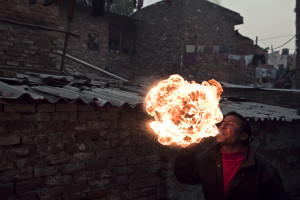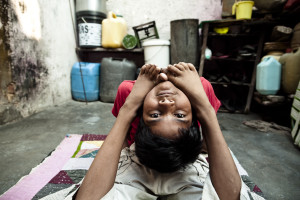 Review: Wisconsin Film Festival
Review: Wisconsin Film Festival
Tomorrow We Disappear | Adam Weber, Jimmy Goldblum | USA | 2014 | 84 min
Wisconsin Film Festival, Chazen Museum of Art, Friday, April 10, 12:30pm»
Wisconsin Film Festival, Chazen Museum of Art, Saturday, April 11, 2:45pm»
There are very few times you can look away from the documentary Tomorrow We Disappear. The viewing experience is like watching the blink-and-you-miss-it magic that the artists of the Kathputli colony practice every day, since they were born, for a hundred years in Delhi, India.
Tomorrow We Disappear is a surreal survey with dream-like cinematography documenting the Kathputli artists’ colony, a sprawling urban family of street performers and magicians, acrobats and puppeteers. Their home in the slums is now threatened by developers, whose shining skyscrapers will displace these keepers of their culture.
 The entire movie is like a Julian Schnabel guest-directed an episode of Vice; beautiful and odd, dizzying in its color and character if not exactly in breadth. We see into many lives, peek under many marquees, but as the film proceeds, one man’s story emerges from the others. We follow puppeteer Puran Bhatt to the end, riveted to his face, his hands, his marionettes. Puran, anguished, shows the camera a puppet his uncle made for his father, in a room of belongings he will soon lose, as the developers make room for New Dehli’s first skyscraper.
The entire movie is like a Julian Schnabel guest-directed an episode of Vice; beautiful and odd, dizzying in its color and character if not exactly in breadth. We see into many lives, peek under many marquees, but as the film proceeds, one man’s story emerges from the others. We follow puppeteer Puran Bhatt to the end, riveted to his face, his hands, his marionettes. Puran, anguished, shows the camera a puppet his uncle made for his father, in a room of belongings he will soon lose, as the developers make room for New Dehli’s first skyscraper.
All of the sudden the film, heretofore as lively as an auction, goes silent, and Puran, without saying a word, sweeps the puppet’s hand across his face, a small performance to express his sorrow, for which he has no words. The sequence is as surreal and unnerving as any Quay Brothers film, as earnest as a love letter, and, frankly, stunning. There was no air in the room anymore. My heart was racing. And then, just as unceremoniously the moment passed. Then Puran the man returned.
Puran is as invested in the documentary as any producer, any do-gooder or journalist who’s heard of the prismatic slum and its famous inhabitants. Celebrated in Salman Rushdie’s epic Midnight’s Children, the colony has been sought after for years by people who want to experience the old culture, the secret trades that they have been practicing for generations. Puran addresses the camera immediately, in a powerful directive I’ve rarely seen in documentaries: the subject asks to be filmed, insisting that the camera show everything, everywhere. Puran wants Kathputli documented so one day he can look at the images and remember, “This is how we lived.”
Despite the film’s discontinuous editing, the small, occasional shifts back and forth in time only enhance our understanding of the story. The filmmakers provide clear markers of where we’re moving and why. The film is chock full of amazing moments; some will move you to tears, while others will provoke real squirms of discomfort. There are jaw-dropping images and discombobulating sequences that provide real ham-fisted punches to the gut.
A young and lovely acrobat called Maya delivers several performances that quite literally stopped me in my tracks. We’re introduced to her peripherally: we see her stretching, practicing here and there among her family before we ever learn her name. And then we discover that she’s an acrobat, and Kathputli families begin training their acrobats when they’re just eight months old. In one breath, Maya says they teach the children not to fear, and in the next, she proudly shows us how she can bend “the wire,” which is a long metal pole, that she wrangles into submission using only her body, and her soft young neck. I couldn’t look away, but I also wanted to jump out of my seat and run away.
This physical strength is nothing compared to her mental strength, her grace. She’s one of the Kathputli artists who does not fear the developers. She wants to take a computer course, or maybe be a teacher. She’s facing the future with poise and hope, and then all of a sudden, a woman who we assume is her mother walks heavily into the room, settles in the background out of focus, and delivers a crushing blow to Maya: she explains why Maya is “unsuited for marriage.” The camera remains tight on Maya’s motionless face, a profound range of feelings crossing her face like lines on a map. It’s the kind of emotional moment and clever framing that indie dramas live and die on. But in this documentary, about so many lives and so much magic, it’s delivered as casually as passing a dish at dinner.
There are compositions throughout the film that stun powerfully in this way. Cinematographer Will Basanta, who shot 2011 festival circuit favorite Jess + Moss, operates and focuses at the same time (often a job for two people on a larger production), which produces a constantly refocusing, dreamlike effect, and an asymmetrical framing that lends an emotional quality to conversations that, in other set ups, might not affect so much. Although production was quite small, the filmmakers beautifully capture everything with an auteur’s eye and ear: oddball pairs working the streets, parade sequences, Puran’s impassioned letter to the housing minister.
Directors Weber and Goldblum seem to reference canonical narrative directors, in form and in content. I see the peculiarly talented set of misfits of a Jean-Pierre Jeunet film, and the lyrical camera movements of early David Gordon Green. Puran’s letter to the minister is as poignantly absurd as anything ever written by Wes Anderson. I can’t deny the influence of Satyajit Ray’s gritty realism at work here, either, as well as the post-modern techniques of the French New Wave. To me, this seems like film-school-kids-done-good, done best, perhaps: young filmmakers with a social consciousness, a knack for magic, a yen for storytelling, and the style to tell.